
table of contents
- Overview of ground cover
- Plants from A - E
- Plants from F - J
- Plants from K - O
- Plants from P - S
- Plants from T - Z
- frequently asked Questions
Ground covers not only set beautiful accents in the garden, they are also very easy to care for. In addition, there are varieties and species that provide the bees and others with plenty of food.
In a nutshell
- Bee-friendly ground cover are easy to care for, robust and fit into every garden
- There are different types and varieties of ground cover for a wide variety of locations
- supplying bees with nectar and poles over several months through different flowering times
Overview of ground cover
Ground covers in the garden are a good choice, especially if they are bee-friendly and help the bees find food. In addition, they are also practical and extremely easy to care for. Mainly they are suitable for unfavorable areas in the garden, for example under trees, on edges or slopes. There is a suitable ground cover for every location.
Plants from A - E
Andean cushion (Azorella trifurcata)

- Growth height 5 to 8 cm
- Spread 20 to 30 cm
- yellow-green flower umbels
- Flowering period May to June
- sunny to partially shaded locations
- Soil stony, sandy to loamy, slightly alkaline to neutral, moderately dry
- extremely bee-friendly
Bergenia (Bergenia)
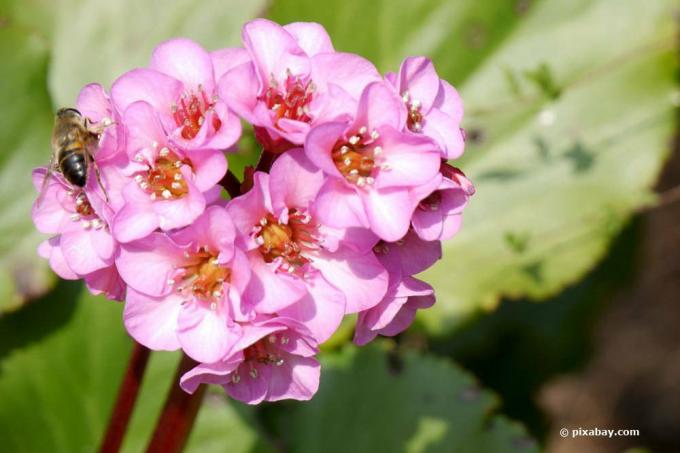
- Growth height 20 to 40 cm
- Spread 35 to 40 cm
- Flower color pink
- Flowering period April to May
- partially shaded to shady locations
- well-drained, nutrient-rich soil
Blue pillow (Aubrieta deltoidea)

- Growth height 10 to 15 cm
- Lawn-forming pillow and cushion shrubs
- Flowers purple-blue to purple-red
- Flowering period April to May
- sunny locations
- also tolerates windy and cold places
- nutrient-rich soils
- Upholstered phlox and Caucasian rockcress as neighbors
Tip: After flowering, the plant can look a little messy. After the tendrils have been cut back, a new, beautiful cushion is formed.
Blood-red cranesbill (Geranium sanguineum)
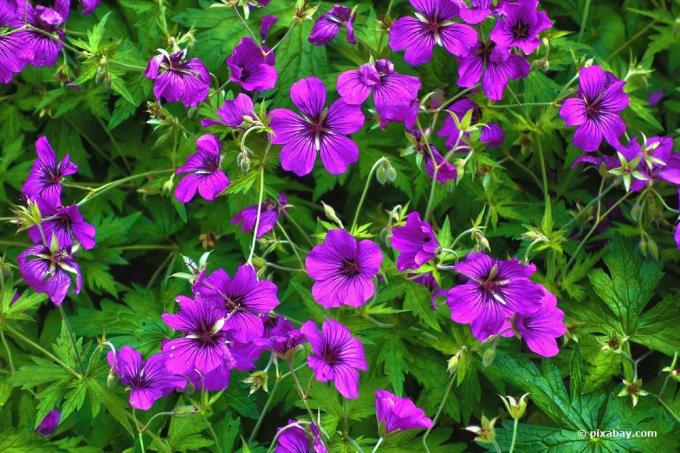
- Growth height up to 40 cm
- Flowers blood red, sometimes white
- Flowering period May to June
- sunny to partially shaded locations
- prefers moist, deep soil
- Yellow larkspur as a neighbor
Brown elk (Prunella vulgaris)

- Height 5 to 20 cm
- Spread 50 to 80 cm
- Flowers purple to blue
- Flowering period June to September
- sunny to partially shaded place
- prefers sandy to clayey soil
- Lime-tolerant Byzantine woolen ziest (Stachys byzantina)
- Growth height 30 to 40 cm
- Spread 25 to 30 cm
- Flower color purple, pink
- Flowering period July to August
- sunny location
- slightly dry, well-drained, nutrient-poor soil
Ivy (Hedera helix)

- Climbing height of up to 500 cm
- Flowers inconspicuously light yellow
- Flowering period from September to October
- sunny to shady locations
- can handle any soil
Plants from F - J
Feather carnation (Dianthus plumarius)

- Growth height 10 to 30 cm
- Spread 20 to 30 cm
- Flower color white, pink
- Flowering period June to July
- sunny locations
- Loamy-sandy, nutrient-rich, well-drained soil
Rock stone herb (Alyssum saxatile)

- Growth height 15 to 30 cm
- Flowers yellow
- Flowering period April to May
- sunny location
- loves dry soils
- particularly suitable for rock gardens, dry stone walls and borders
Tip: After flowering, it should be cut back to 5 cm above the ground. This keeps the upholstery nice and bushy.
Felty thyme (Thymus praecox)
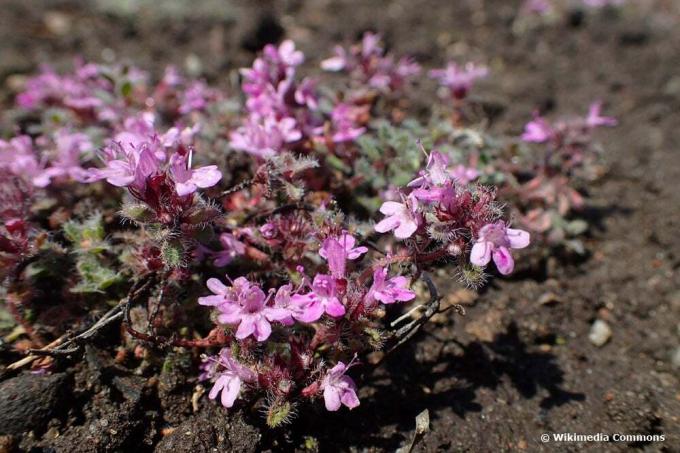
- 3 to 5 cm in height
- Spread 20 to 25 cm
- Flower color pink
- Flowering period May to June
- sunny locations
- dry, well-drained soil
- extremely bee-friendly
Finger shrub (Potentilla fruticosa)

- Growth height 50 to 130 cm
- Spread 50 to 150 cm
- Flowers yellow, orange, red, pink, white
- Flowering period June to October
- sunny location
- prefers sandy-loamy soils
Spring Adonis (Adonis vernalis)

- Growth height 10 to 20 cm
- Flowers yellow
- Flowering period April to May
- sunny locations
- prefers calcareous and humus-rich soils
- small trees like Pinus montana as neighbors
Yellow Larkspur (Corydalis lutea)
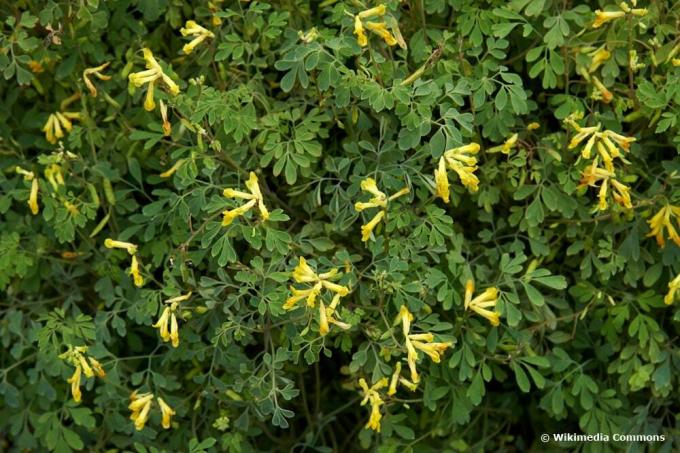
- Growth height 15 to 30 cm
- Flowers yellow
- Flowering period May to September
- prefers partially shaded to shady locations
- fresh, not too dry soil
Pedunculated speedwell (Veronica peduncularis)
- Growth height 10 to 15 cm
- Spread 20 to 30 cm
- Flower color dark blue
- Flowering period April to July
- sunny to partially shaded locations
- loamy-sandy, stony soil
Common carnation (Armeria maritima)
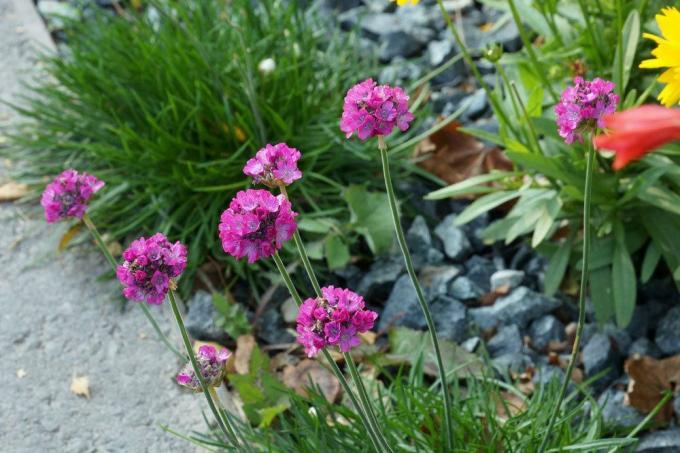
- Growth height 10 to 20 cm
- Flowers pink to carmine red
- Flowering period May to July, sometimes to September
- location in full sun
- well suited for edging, stone and heather gardens
- sandy, dry soil preferred
Golden strawberry (Waldsteinia fragarioides)

- Growth height 20 to 30 cm
- Flowers yellow
- Flowering period April to May
- sunny to partially shaded place
- ideally suited as underplanting under deciduous trees
- prefers deep, not too poor soil
- bee-friendly forest foam blossom as a neighbor
Gold basket (Chrysogonum virginianum)

- Height of growth 25 cm
- Spread 30 cm
- Flower deep yellow
- Flowering period May to April
- sunny to slightly shady locations
- humus-rich, well-drained, freshly moist soil
- extremely bee-friendly
Golden nettle (Lamium galeobdolon)

- Height of growth 25 cm
- Spread 35 cm
- Flower yellow
- Flowering period May to June
- partially shaded to shady locations
- well drained, humus soil
Great chickweed (Stellaria holostea)
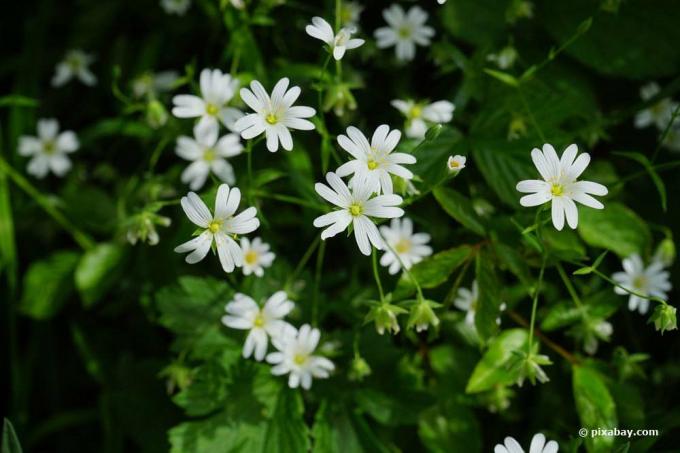
- Height of growth 40 cm
- Spread 35 cm
- large, star-shaped, white flower
- Flowering period April to June
- partially shaded locations
- Fresh, slightly acidic, humus-rich, well-drained soil
Tip: So that the plants can stay in their place for years, this should be processed with leaf compost or manure peat in autumn.
Plants from K - O
Catnip (Nepeta racemosa)
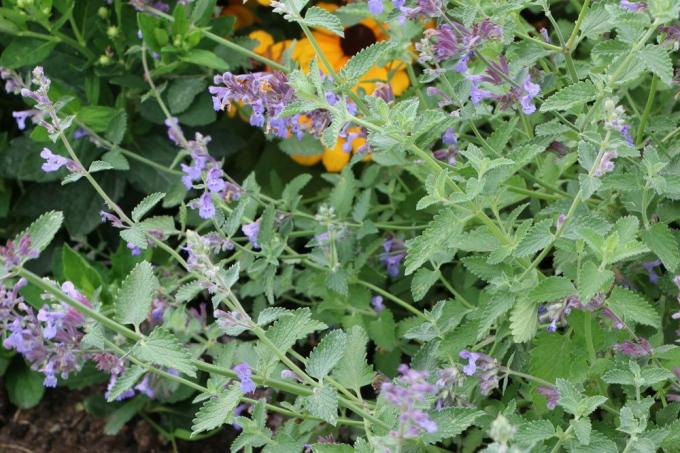
- Height of growth 30 to 60 cm
- Flower color lavender blue
- Flowering period May to September
- dry, full sun locations
- prefers well drained soils
- tolerates drought
- Sun eye as a neighbor
Cat's paw (Antennaria dioica)

- 3 to 10 cm in height
- Spread 15 to 20 cm
- The flower is silver-pink
- Flowering period May to June
- sunny to partially shaded locations
- Soil dry, fresh, low in lime, well drained
Caucasian rockcress (Arabis caucasica)
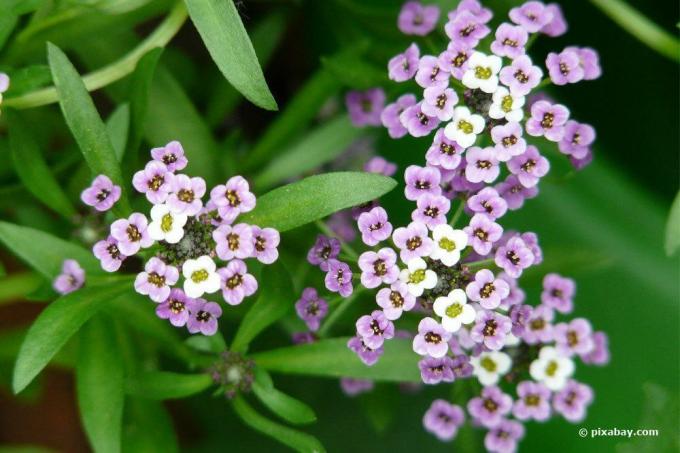
- Growth height 10 to 20 cm
- white cruciferous flowers
- Flowering period March to April
- sunny location
- preferred for rock gardens and dry stone walls
- grows on every garden soil
Note: There are different cultivars with pink or double white flowers.
Caucasian comfrey (Symphytum grandiflorum)

- Growth height 20 to 30 cm
- pale yellow, tubular flowers
- Flowering period April to May
- semi-shady to shady location
- humus-rich, fresh soils
Cushion gorse (Cytisus decumbens)

- Growth height 20 cm
- Width 80 cm
- Bright yellow flower
- Flowering period May to June
- sunny locations
- well-drained soil
- extremely bee-friendly
Clover-leaved foam herb (Cardamine trifolia)

- Growth height 10 to 20 cm
- Flower color white
- Flowering period May to June
- sunny to partially shaded places
- prefers fresh to moist, humus and nutrient-rich soils
- Elven flower or narrow-leaved lungwort as a neighbor
Small-leaved periwinkle (Vinca minor)

- Growth height 10 to 15 cm
- Spread 30 to 60 cm
- Flower blue
- Flowering period April to May
- partially shaded to shady locations
- Soil loamy-sandy, fresh, rich in humus
Little blood barberry (Berberis thunbergii)

- Height 50 cm
- Spread 50 cm
- yellow clusters of flowers
- Flowering period May to June
- sunny to partially shaded locations
- sandy-humic soil
Compact hornwort (Cerastium tomentosum)

- Growth height 10 to 15 cm
- Spread 20 to 25 cm
- Flower white
- Flowering period May to June
- sunny locations
- Soil dry, loamy-sandy, poor in humus and nutrients
Lavender (Lavandula angustifolia)

- Height of growth 30 to 60 cm
- Flower color from violet-blue to lilac
- Flowering period June to August
- dry, warm, full sun locations
- well drained, calcareous soils
- Catnip or summer sage as a neighbor
- extremely bee-friendly
Tip: In the spring, pruning is advisable in order to obtain compact cushions.
Liver balm (Ageratum houstonianum)
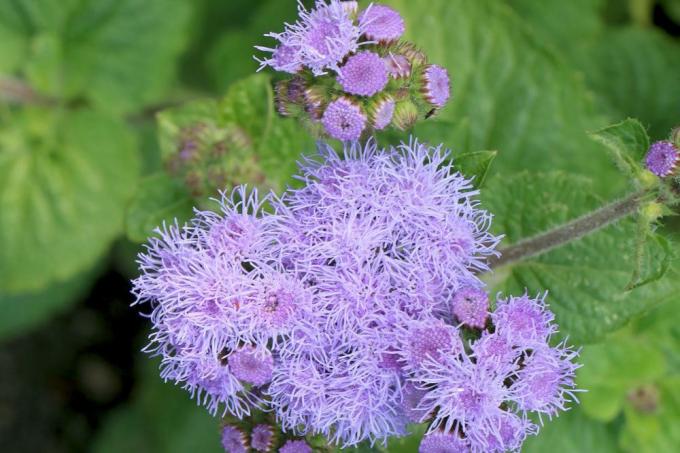
- Growth height 10 to 12 cm
- Flowers blue, also pink and white hues
- Flowering period May to October
- full sun places
- prefer well drained, humus-rich garden soil
Tip: In order to lengthen the flower pile, what has flowered should be removed regularly.
Hepatica (Hepatica nobilis)

- Height 7 to 15 cm
- purple to blue single flowers
- Flowering period March to April
- partially shaded to shady place
- preferably under deciduous trees
- loves sandy-loamy soil
- tolerates lime
Loyal to men (Lobelia erinus)

- Growth height 10 to 20 cm
- Flowers blue, white, purple
- Flowering period June to August, often also to September
- prefers sunny locations
- nutrient-rich garden soil necessary
- ideal for edging flower beds
- annual
Morocco - chamomile (Anacyclus pyrethrum)
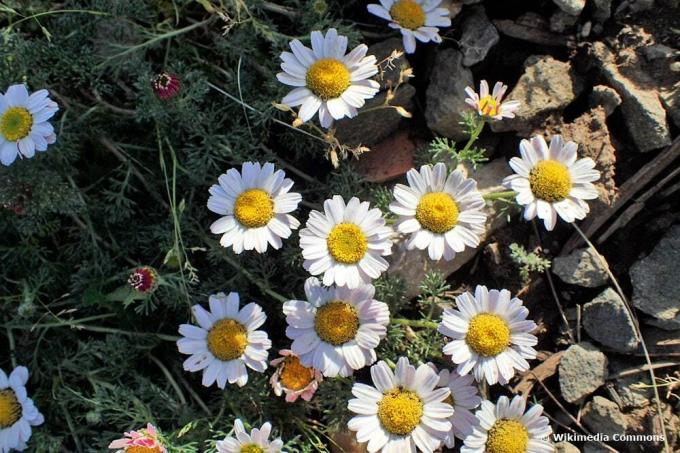
- Growth height 10 to 15 cm
- Flower white
- Flowering period June to August
- sunny locations
- fresh, well-drained soil
Tip: After pruning after the first flowering, a second pile is made in late summer.
Plants from P - S
Cushion bellflower (Campanula portenschlagiana)
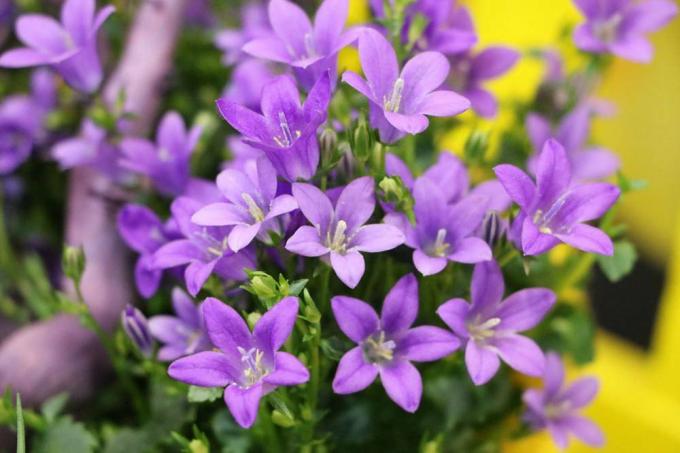
- Growth height 10 to 15 cm
- purple corollas
- Spread 20 to 30 cm
- Flowering period June to August
- sunny to partially shaded locations
- prefers sandy-loamy soils
Splendid spar (astilbe)

- Height of growth 40 to 100 cm
- small single flowers in white, pink, red
- Flowering period July to August
- semi-shady to shady location
- light and moist soil
- Silver candle and autumn anemone as neighbors
Rose Woodruff (Phuopsis stylosa)

- Growth height 20 cm
- Spread 35 cm
- pink scented flower balls
- Flowering period June to August
- sunny to partially shaded locations
- well-drained, sandy-humic soil
- extremely bee-friendly
Red summer sparrow (Spiraea japonica)

- Height of growth 15 cm
- Width 60 cm
- red umbels
- Flowering period July to September
- sunny to partially shaded locations
- Soil sandy-humic
Red-leaved Gunsel (Ajuga reptans)

- Growth height 10 to 15 cm
- Spread 25 to 30 cm
- Violet-blue flower
- Flowering period May to June
- sunny to partially shaded locations
- fresh, humus-rich, moist, well-drained soil
Red moss stonecrop (Sedum album)

- Height of growth 5 to 10 cm
- Spread 15 to 20 cm
- Flower white
- Flowering period June to August
- sunny locations
- dry, well drained soil
Red and white piebald knotweed (Polygonum affinis)
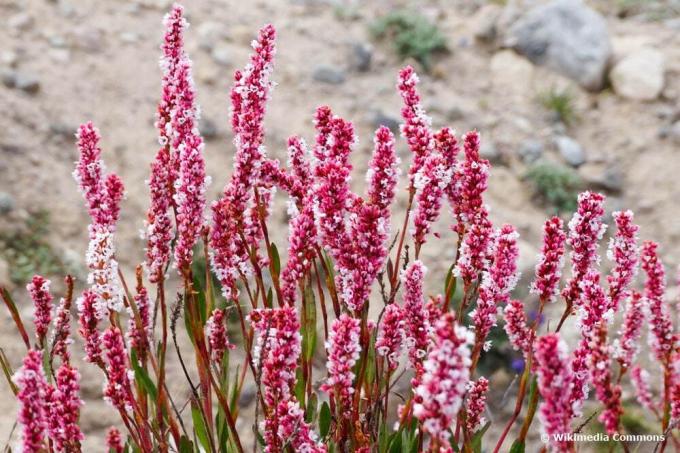
- Height of growth 25 cm
- Flowers white to red
- Flowering period May to October
- sunny to partially shaded place
- normal garden soil is sufficient
- also grows in barren locations
Spicy stonecrop (Sedum acre)
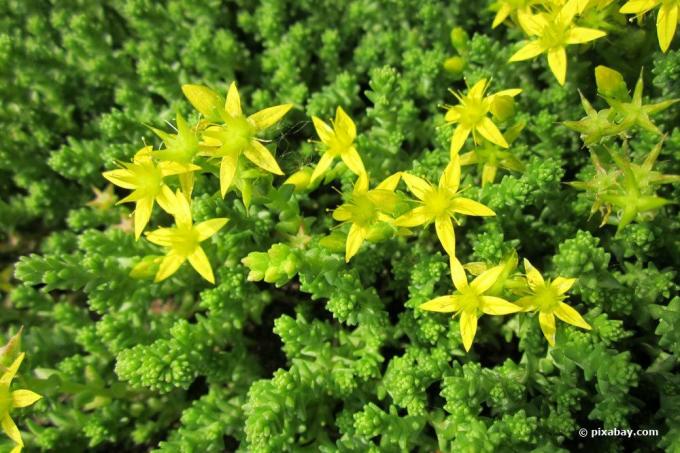
- Height of growth 5 to 10 cm
- Spread 10 to 20 cm
- bright yellow flowers
- Flowering period June to July
- sunny to partially shaded locations
- loves stony to sandy soils
- lime tolerant
- extremely bee-friendly
Foam cress (Arabis procurrens)

- Height 5 to 15 cm
- Spread 20 to 30 cm
- Snow-white flower
- Flowering period April to June
- sunny to partially shaded locations
- Well-drained, fresh, slightly acidic to alkaline soil
Snow Carpet Fettblatt (Sedum spurium)

- Growth height 10 to 15 cm
- Spread 20 to 25 cm
- Flower white
- Flowering period July to August
- sunny to partially shaded locations
- fresh, well-drained soil
Summer sage (Salvia nemorosa)
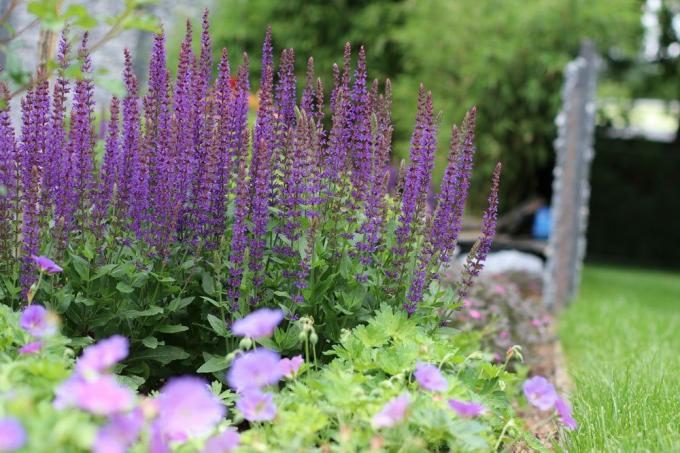
- Growth height 40 to 70 cm
- Flower color purple, blue, white, pink
- Flowering period May to September
- prefers sunny locations
- calcareous, moderately dry, well drained soils
- Gold sheaf or globular thistle as a neighbor
Spanish daisy (Erigeron karvinskianus)
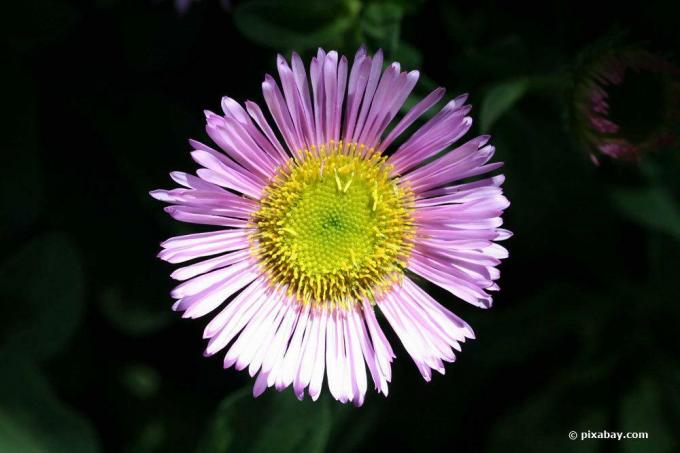
- Growth height 20 to 30 cm
- Spread 20 to 30 cm
- Flower white, pink
- Flowering period May to September
- sunny to partially shaded locations
- well-drained, fresh soil
Perennial ice plant (Delosperma cooperi)

- Growth height 10 to 15 cm
- Spread 20 to 30 cm
- Flowers violet-purple, almost white center of the flower
- Flowering period June to August
- sunny locations
- Soil dry, stony, poor in humus, well drained
Stone aster (Aster ericoides)

- Height of growth 5 to 10 cm
- Spread 30 to 40 cm
- Flower white
- Flowering period from September to October
- sunny to partially shaded locations
- Well-drained soil, dry to fresh
- extremely bee-friendly
- popular ground cover
Stemless gentian (Gentiana acaulis)
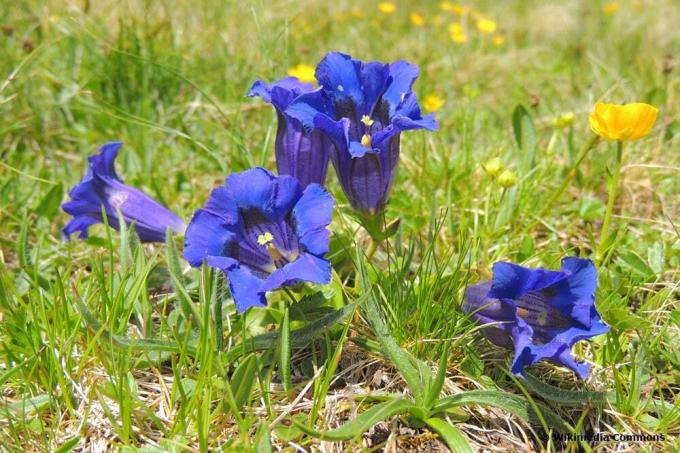
- Growth height 20 cm
- dark azure funnel-shaped flowers
- Flowering period May to November
- location in full sun
- loves heavy, loamy soil with plenty of moisture
Sündermann Silberwurz (Dryas x suendermannii)

- Height 5 to 15 cm
- Spread 20 to 30 cm
- Flower white with a yellow center
- Flowering period June to July
- sunny locations
- sandy-gravelly, fresh, well-drained soil
Plants from T - Z
Carpet sheaf (Achillea tomentosa)

- Height 5 to 20 cm
- Spread 15 to 30 cm
- Flower deep yellow
- Flowering period June to July
- sunny locations
- dry, fresh, nutrient-poor, well-drained soil
Carpet Phlox (Phlox subulata)

- Height 5 to 15 cm
- Spread 20 to 30 cm
- Flower color from purple to blue, pink to white, also multicolored
- Flowering period April to June
- sunny to partially shaded location
- loves sandy-stony soils
- sensitive to lime
Carpet dogwood (Cornus canadensis)

- Growth height 10 to 20 cm
- Flowers green
. Flowering period May to June - partially shaded places
- prefers sandy-loamy soils
Carpet gypsophila (Gypsophila repens)

- Growth height 10 to 15 cm
- Spread 20 to 30 cm
- Flower pale pink
- Flowering period May to June
- sunny locations
- Fresh, nutrient-poor, well-drained soil
Loquat (Cotoneaster dammeri)

- Height of growth 15 cm
- Spread 45 cm
- Flower white
- red berries in autumn
- Flowering period May to June
- sunny to shady locations
- no demands on soil
Turin Woodruff (Asperula taurina)

- Height 50 cm
- Spread 35 cm
- Flower white
- Flowering period May to June
- partially shaded to shady locations
- fresh, well-drained soil
White dead nettle (Lamium maculatum)

- Growth height 20 cm
- Spread 25 cm
- lip-shaped, white flower
- Flowering period May to July
- partially shaded locations
- well drained, humus soil
- extremely bee-friendly
Cotoneaster (cotoneaster horizontalis)

- popular ground cover
- Flowers pinkish white
- Growth height 100 to 150 cm
- Flowering period May to June
- sunny to partially shaded locations
- prefers well-drained, sandy-loamy soils with a medium nutrient content
frequently asked Questions
Due to large-scale monocultures, bees can no longer find many suitable sources of food. The population is steadily decreasing. The use of bee-friendly plants in the garden can make a small contribution to protecting bee colonies.
No. As a rule, these are very easy to care for. Additional watering should be given during prolonged dry periods. Depending on the type and variety, pruning is sometimes necessary. In the spring, a basic fertilization should take place, for example with horn shavings.
Ground cover in general are woody plants and perennials with low growth heights that grow quickly and densely. You can wear a leaf or flower decoration. Depending on the species, the leaves are summer or winter green. They are bee-friendly if they have a high content of pollen and nectar and have a long flowering period. Its flowers are unfilled and wide open so that the bees can get to the food source unhindered.



